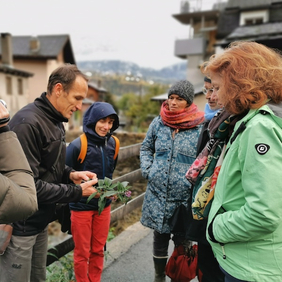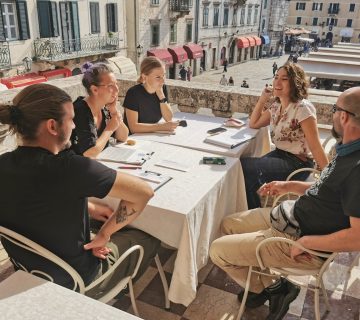The participants of a five-day CIG course completed in the UNESCO World Heritage Swiss Alps Jungfrau-Aletsch in Naters dealt with this topic and other questions around it – What do glaciers, animals, traditions or museum visits trigger in visitors? How is emotion aroused and tension built in a guided tour? The aim of the course was to inspire visitors for nature, culture and landscape and to create lasting experiences.
Heritage interpretation is the ‘interpretation of natural and cultural landscape’. It is a method to create a connection between visitors and objects from natural and cultural landscapes. A method that can be applied everywhere, as Thorsten Ludwig, our course leader and Managing Director of IE, proved time and again in his guided tours during the course.
But before the participants ventured into this new methodology, key concepts – such as phenomenon, themes, facts and meaning – were clarified. They later served as a tool for the new leadership methodology: away from the mere transmission of facts and towards highlighting the uniqueness of a phenomenon. With the aim of linking the phenomenon with the personality of the participants, to create a resonance in order to awaken a deeper meaning in them.
This sounds very theoretical, but it is not! In order to understand the terms, various exercises were carried out in the theory room as well as outside in the environment.
With the familiar terms of the first day in our luggage, a short interpretation was compiled on the second day at the edge of the large Aletsch glacier. The aim of this presentation was to use the selected phenomenon to develop a suitable theme that gets under the skin and inspires the group to engage in dialogue.
On the third day of the course, the group went from Naters to Ausserberg – a small village on the Lotschberg south ramp. Today, the village centre still consists of numerous stable barns, barns and warehouses in the typical Valais style. A museum has been set up in one of these houses with the aim of giving visitors an insight into the traditional way of life in the past. The two working groups prepared, presented and discussed the interpretation processes on the basis of the main idea and theme lines. The working technique of mindmapping was also used, presented and practiced accordingly. Finally, peer coaching tested and was applied to the practical example.
The second part of the course took place one month later. In addition to dealing with open-ended questions, the focus was now on the development of main themes, roving interpretation and live interpretation. The practical application in the form of exercises, evaluation and discussion of the findings received a lot of space in this course unit. But the forms of deepening sustainable development as well as accessibility were not neglected. The guided tour through the World Nature Forum could also be classified as a practical exercise, followed by the final day – the associated examination.
The last day was devoted entirely to the final examination for certification: in addition to the theory test in the form of a written test, each participant carried out a brief interpretation in Naters. 20 examination criteria had to be taken into account and various aids had to be used. After the great tension had given way, the participants were given the opportunity to listen to the final in-depth discussions, for example on the history of the interpretation. After an exchange of personal impressions, everyone was not only interested in the certificate, but especially in the valuable methodology and many shared experiences.
Alessandra Lochmatter is Head of Sustainable Development for the UNESCO World Heritage Swiss Alps Jungfrau-Aletsch. She can be contacted at: a.lochmatter@jungfraualetsch.ch.
To cite this article:
Lochmatter, Alessandra (2019) ‘CIG course in the Swiss Alps’. In Interpret Europe Newsletter 4-2019, 12.
Available online: www.interpret-europe.net/fileadmin/Documents/publications/Newsletters/ie-newsletter_2019-4_winter.pdf




